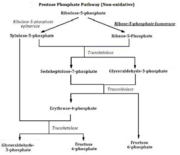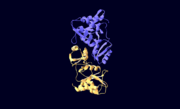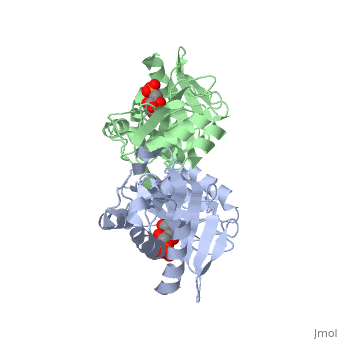Introduction
Ribose 5-phosphate isomerase (Rpi) is a highly conserved protein that acts as an enzyme in both eukaryotic and prokaryotic metabolic pathways[1]. Specifically, Rpi catalyzes the reaction that converts (R5P) to ribulose-5-phosphate (Ru5P). Rpi exists as two distinct protein forms known as RpiA and RpiB, both of which catalyze the same reaction, and most organisms express one or both of these enzymes.
The functional and structural properties of RpiA have been determined from organisms including Escherichia coli, Pyrococcus horikoshii, Saccharomyces cerevisiae, among others[1]. These studies have revealed an important role RpiA plays in the Calvin cycle in plants and pentose phosphate pathway in both plants and animals [2]. The sequence conservation among RpiA subfamilies also shows the considerable evolutionary significance in preserving its function across different organisms.
- RpiB does not exist in humans and is structurally unrelated to RplA[3].
Function
Pentose Phosphate Pathway
The pentose phosphate pathway is comprised of two separate pathways, the oxidative and non-oxidative paths. In the non-oxidative pathway RpiA converts Ru5P to R5P, subsequently the ribulose phosphate 3-epimerase converts the R5P to xylulose-5-phosphate[2]. The pentose phosphate pathway is a major source of NADPH, which is necessary for the removal of oxidants within cells[1].

Figure 1: Non-oxidative pentose phosphate pathway
Calvin Cycle
The Calvin Cycle converts carbon dioxide and water into carbohydrates which can be utilized by the organism. RpiA plays an important role in the cycle, converting ribose-5-phosphate to ribulose-5-phosphate, which is subsequently converted to ribulose 1,5,-biphosphate (RuBP). RuBP is further reacted to form glyeraldhyde-3-phosphate, which is a precursor to the formation of larger carbohydrates[1].
Structure
The structure of RpiA has been identified in many organisms including E. coli and Vibrio vulnificus. The crystallized RpiA structure from both of these organisms is highly conserved in many respects. RpiA exists as a dimer with pseudo-2-fold symmetry, the interface of the dimer is composed of six different segments, which contain a number of interactions occurring between and . Two salt bridges also link of the same subunit. The occurs through the interaction between the ligand (R5P) and the following residues in the RpiA: . RpiA contains . The VvRpiA-R5P complex resembles the E. coli RpiA-A5P complex; however the VvRpiA-A5P complex reveals a different position than the R5P binding mode. The A5P interacts with the following residues: Asp8, Lys7, Ser30, Asp118 and Lys121.
Medical and Future Implications
Ribose-5-Phosphate Isomerase deficiency has been associated with the progression of leukoencephalopathy [4]. Leukoencephalopathy is a disorder associated with the deterioration of white-matter in brain tissue, and individuals with this diseases exhibit neurological deficits, such as psycho-motor retardation[4]. A study performed by Huck and colleagues, revealed the Rpi gene-sequence of having a frameshift and missense mutation, which led to a defect in the pentose-phosphate pathway, which was prevalent in patients suffering from leukoencephalopathy[4].

Figure 2: Ribose-5-Phosphate Isomerase A
In a study done by Becker and colleagues, RpiA was shown to play an important role in the pathogenesis of the malarial parasite, Plasmodium falciparum, which is one of the species of Plasmodiumthat causes malaria in humans[5]. The RpiA specifically supplies the increased requirement of R5P required by Plasmodium cells that use the R5P to generate 5-phospho-D-ribose-a-1-pyrophosphate (PRPP) needed for nucleic acid synthesis[5].
A major issue in agriculture is related to the overuse of antibiotics. In recent history there has been an increase in scientific data showing the direct relationship between the overuse of antibiotics in the agricultural industry, resulting in the cultivation and spread of antibiotic-resistant bacteria. A large number of bacteria presenting abnormal symptoms in infected organisms results from unbalanced cellular ribose levels, and a proposed treatment for this type of infection is creating inhibitors that target RpiA, which would have adverse affects on the pathogenic bacteria[6].
Ribose 5-Phosphate Isomerase plays a huge role in producing nucleotides and cofactors from ribose 5-phosphate in the pentose phosphate pathway and calvin cycle. Since this enzyme plays a major role in both eukaryotic and prokaryotic organisms it is a valuable enzyme and implies that RpiA subfamilies have a significant evolutionary origin[7].
3D structures of ribose-5-phosphate isomerase
Ribose-5-phosphate isomerase 3D structures



